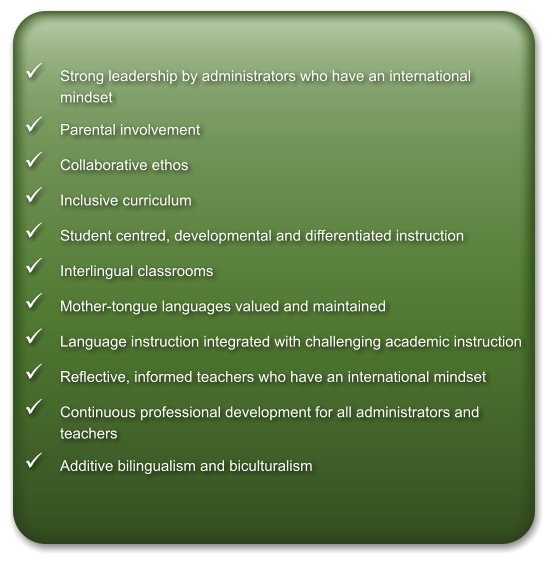


A handbook for new ESL parents
The first days a
A handbook for new ESL parents
The first days at school can be especially stressful for ESL children and their parents. This handbook can be given to
parents, maybe during their first open-day meeting with the ESL teacher. It helps explain to ESL parents what to
expect, how to help their children and provides answers to many frequently asked questions.
This resource is provided as a MSWord document to be downloaded and tailored to your school’s context.
Features of an effective international school
Eithne says: “I believe schools need to have a shared vision and an overiding collaborative ethos where there is
genuine respect for diversity and language is viewed as a right and a valuable resource. Only in this way will all
languages and cultures have equal rights to the curriculum.”
Click on the button to the right to see a high level check-list to verify a school’s international mindedness.
An ESL, language acquisition & mother-tongue reading list
This PDF file contains a useful reading list with over 120 references to some of the most important writers in the field
of language acquisition.
What the children say ...
This video features short speeches from young ESL students that convincingly put the case for allowing all languages
into the classroom. Presented at the International School of Stuttgart for their 2010 UNESCO Mother Language
Celebration Day, it underlines how Interlingual classrooms allow ESL children to use their mother-tongues to “learn
across languages”.
Thanks to Petar Silobrcic for the technical support.
How internationally minded is your school ?
Michael J. Allan, Intercultural Awareness Leader at the International School of Amsterdam, has developed an
Internationalism Audit to help evaluate just how internationally minded a school really is. He says, “Although
international understanding or intercultural awareness forms part of the declared philosophy of IBO and other
international schools, very few would be able to point to a coherent, monitored and evaluated programme for
internationalism.”
This document provides an example of how Michael’s research-based approach for assessing the level of
internationalism could be implemented.
An identity text fairytale
In this video ESL children present an identity text fairytale they produced collaboratively for a group of blind children
at a local charity. It is an excellent example of the use of identity texts. The story was presented to peer groups in
school and a CD & booklet were produced to sell and raise money for a school in Zambia.
Grandparents, aunts, uncles and friends of Grade 4 all over the globe received copies of our multilingual tale, The
Power of Friendship.
Go here for a description of how this project was organised and for more on identity texts.
What is an Interlingual classroom ?
The children in our International School classrooms should not just be described as monolingual, bilingual or
multilingual. These classifications only create distinctions and barriers. We need a new word which promotes a
mindset of inclusiveness.
Interlingual does just that. All children (and all parents) have equal standing in an Interlingual classroom.
This document explains why.
4:08

4:55









© Eithne Gallagher 2012 - 2020
Last reviewed / updated May 2020





![Close [x]](index_htm_files/close.png)

















